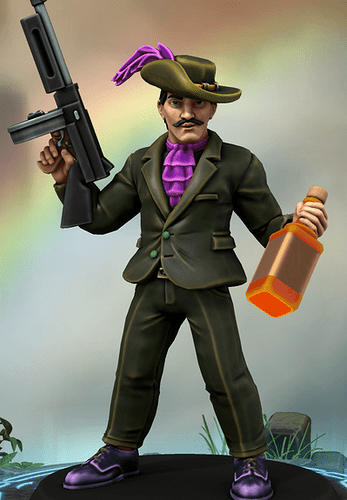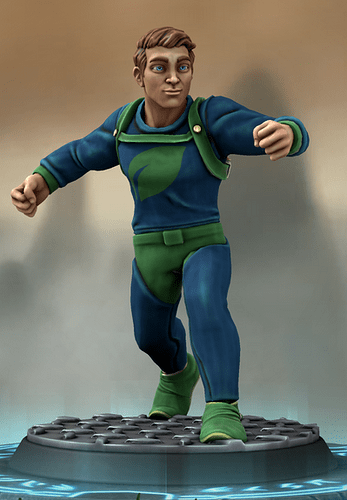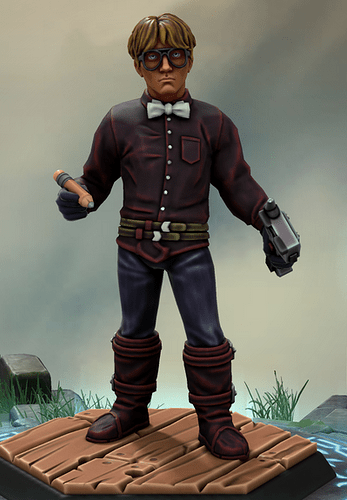The Randomizers:
Background 1, 10, 2 [Options: Blank Slate, Criminal, Performer, Unremarkable, Dynasty, Adventurer]
Power Source 8, 4, 10 [Options: Experimentation, Powered Suit, Tech Upgrades, Artificial Being, Alien, Unknown]
Archetype 2, 1, 9 [Options: Speedster, Shadow, Powerhouse, Elemental, Robot/Cyborg, Sorcerer]
Personality 6, 3, 8 [Options: Impulsive, Distant, Fast Talking, Inquisitive, Stoic, Decisive]
The Tellurian
Real Name: Tom Taylor, First Appearance: Celestial Travels #49, Mar 1943
Background: Blank Slate, Power Source: Alien, Archetype: Physical Powerhouse
Personality: Decisive, Principles: Levity, Expertise
Status Dice: Green d8, Yellow d8, Red d10. Health: 32 [Green 32-25, Yellow 24-12, Red 11-1]
Qualities: Close Combat d10, Conviction d8, Leadership d8, Fitness d8, Outside Perspective d8
Powers: Strength d10, Presence d8, Gadgets d8, Leaping d8, Vitality d6
Green Abilities:
-
Hit Hard [A]: Attack using Strength and use your Max die.
-
Victory Pose [R]: When you eliminate a minion with an Attack using Close Combat, Recover Health equal to your Min die.
-
Principle of Levity [A]: Overcome a dire situation where your jokes prevent demoralization and use your Max die. You and each of your allies gain a hero point.
-
Principle of Strength [A]: Overcome using brute force and use your Max die. You and each of your allies gain a hero point.
Yellow Abilities:
-
In Harm’s Way [A]: Boost all nearby allies using Presence. Use your Max+Mid dice. Hinder yourself with your Min die.
-
Face-Off [A]: Attack using Presence. The target of that Attack must take an Attack action against you as its next turn, if possible.
-
Block [R]: When you are Attacked at close range, Defend yourself by rolling your single Strength die.
Red Abilities
-
Push Your Limits (I): You have no limit on amount of Reactions you can take. Each time you use a Reaction after the first one each turn, take 1 irreducible damage or take a minor twist.
-
Into the Breach [A]: Make a basic action using Leadership. Use your Max die. All other heroes who take the same basic action on their turn against the same target receive a Boost from your Mid+Min dice.
Out
- Boost an ally by rolling your single Strength die.
As World War II progressed and the number of superheroes in Venture Comics grew, there was a concerted push to put at least one hero in the pages of every comic. By early 1943, the only holdout was Celestial Travels; aside from a few backup stories, their lead editor had stubbornly resisted including even alien heroes such as the Steward from their ranks. Finally, Venture’s owners put their foot down, compromising with a planetary romance hero who was mandated to appear in at least six issues over the course of the year, bringing superheroic antics to a faraway world.
The result was the Tellurian. Tom Taylor was a human who was pulled through an interdimensional fissure to the far-flung world of Teulos, where he found himself fighting against an alien empire that was patterned after both Nazi Germany and Imperial Japan. The gravity of the world gave him incredible strength - the lead writer, Kit Grenville, drew heavily on the stories of John Carter for his inspirations - and his natural charisma soon had him leading a rag-tag group of rebels as he searched for a portal that would return him home.
The Tellurian was not a particularly novel hero, echoing several previous planetary romance leads, and his creator was supremely uninterested in his life prior to arriving on Teulos. Instead, the draw of each story was in the world that Grenville drafted for the Tellurian to explore, applying superhero tropes to the planetary romance to foil super-villains, alien fascists, and strange robots. Ultimately, however, the hero’s downfall came from his own staff. Celestial Travels’ editor chafed at the mandate from above, and deliberately moved resources away from the Tellurian to the other stories he was writing, seeing the cheap pulp hero as a way to save art resources for more cerebral galactic tales. As a result, and despite a strong start, sales for the Tellurian’s issues dwindled over the course of 1943, leading to fewer appearances in 1944 and a single final issue in 1945.
The Tellurian would make a brief return in the pages of Vanguards! In 1961, as part of their adventures, the Vanguards would travel to a new world on the forefront of the Jotari’s invasion plans, where they discovered the Tellurian and the people of Teulos. Over the course of a two-parter, the Tellurian bravely sacrificed himself, saving Teulos from the Jotari and leaving the Vanguards to tell his story. It was hard to say if this was a writer delivering the final nail in the coffin of a character they saw as disposable, or a final attempt to give him an ending with dignity, but either way, the character did not return to life.
Behind the Scenes
I knew from the start that I wanted to have one of my Golden Age heroes be a Celestial Travels character who was sabotaged and never had a chance, and combining a “Blank Slate” background, alien powers, and punching pretty much gave us someone halfway between John Carter and Flash Gordon - a charismatic leader of rebels on an alien world, empowered by his human nature. With the right team, he might have been a solid draw, if not a hit, but with his budget kneecapped from minute one it was never going to happen.
It did set the stage for Venture’s heavy use of interdimensional travel alongside interstellar travel, so in that sense, the Tellurian made his mark. Good for him.




 And speaking of problematic writers…
And speaking of problematic writers…